Sights and Activities
Below are the places we saw and activities completed while visiting Brazil:
Foz do Iguaçu
Parque Nacional do Iguaçu: a bus ride took us to the start of a trail along the Iguaçu River that gaves amazing panoramic views of the falls. The trail terminates at the Garganta do Diablo (The Devil’s Throat) where a walkway over the river gets you up close and soaked! An elevator leads to a slightly drier view of the falls from above. It is amazing the quantity of water that passes through.
Bonito
- Balneario Municipal: we spent a day in this natural swimming pool on the Rio Formoso with clear water and lots of fish.
Rio do Peixe: we took a tour through this River of Fish walking on a trail and making stops to see beautiful cascading waterfalls, zip line and falling into the river, jumping from platforms, and a lot of swimming!
Rio da Prata: this tour of the River of Silver involved 3km of floating downstream with a snorkel in crystal clear waters full of fish. We were also able to see the birth of the natural underground spring that is responsible for such amazing beauty.
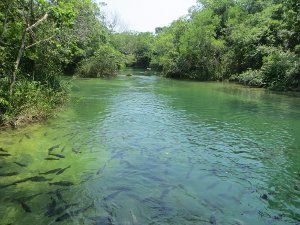
São Paulo
Liberdade: we walked around this neighborhood that has traditionally been a Japanese community. The country has the biggest Japanese population outside of Japan. Though most new Asian immigrants have come from China and Korea, the neighborhood is still lined with traditional Japanese shops and eateries, where we enjoyed a Brazilian-style pay-per-kilo Japanese restaurant.
Museu Historico da Imigracão Japonesa: the Historic Museum of Japanese Immigration documents the arrival and integration of the Japanese community in the country. Exhibitions and explanations included the friendship treaty that was signed between the two countries in 1895, the arrival of the first immigrants in 1908 as farmers, the pace that immigrants came slowed down during and after World War II, and later a new wave of immigrants arrived but this time not only for agriculture but they also started their own businesses.


Memorial da America Latina: a mini-Brasília designed by Oscar Niemeyer with a series of futuristic structures with different exhibitions from Latin America, including immigrants in Brazil, sewn art from Chile and Brazil, and other diverse arts and crafts, including an interesting 3-dimensional map of Latin America.
Pico do Jaragua: we hiked up Jaragua Peak, the highest mountain in the city at 1135m (3724ft) above sea level. Unfortunately, the views of the city were interrupted by heavy clouds.
Praça da Republica: a lively park and public square centrally located.
Teatro Municipal: the construction of this theater begun in 1903 in the style of Paris’ Palais Garnier and hosts the city’s top classical-music, opera, and ballet performances.
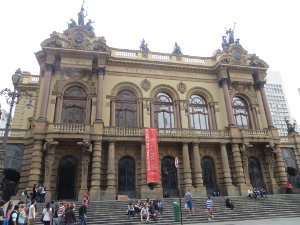

Catedral da Se: this cathedral is located in Praça da Se (Cathedral Square), the old heart of the city. The huge neo-Byzantine structure replaced the original 18th-century structure in the 1920’s.
Pateo do Colegio: a mission that occupyies the exact spot where the city was founded in 1554 by Jesuit brothers José de Anchieta and Manoel da Nóbregra.
Edificio Martinelli: the city’s first skyscraper is a 1929-Beaux Arts building.
- Mosteiro de São Bento: one of the city’s oldest and most important churches dates to 1598, though its neo-Gothic facade dates only to the early 20th century.


Mercado Municipal: we tried the city’s classic mortadela sandwich on the second floor of this covered market filled with stained glass and a series of vast domes. The first floor specialies in fresh produce and dried goods.
Estação da Luz: a functioning classic late-Victorian train station constructed with materials entirely shipped in from Britain and completed in 1901.

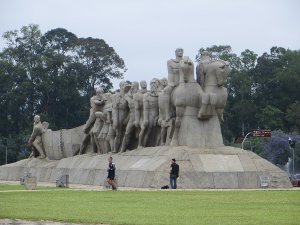
Parque do Ibirapuera: the biggest green space in the city center, this 2-sq-km park hosts a series of museums and performance spaces. Inaugurated in 1954 to commemorate the city’s 400th anniversary, the park was designed by renowned landscape architect Roberto Burle Marx. At the north entrance stands Monumento Bandeiras, erected in 1953 in memory of the city’s early pioneers.
Museu Afro-Brasil: located in Parque do Ibirapuera, this museum features a permanent collection chronicling five centuries of African immigration and hosted a temporary collection of contemporary Afro-centric exhibitions.
Memorial do Imigrante: this impressive museum and memorial starts by documenting various aspects of immigration throughout the world from the beginning of time and then concentrates in the unparalleled racial and ethnic diversity of the country. The museum continues on exhibiting the immigration of the country’s indigenous, African slavery, Portuguese colonization, and 19th and 20th century immigration. The museum is hosted in what was called the Hospedaria dos Imigrantes that was built in 1887 and functioned as a holding place for immigrant labor before they shipped out for their first jobs in the country, mostly on large plantations.
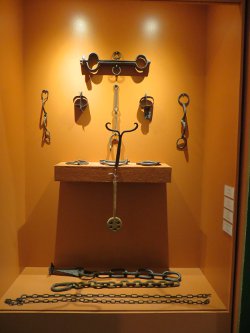
Museu da Lingua Portuguesa: a fascinating exhibition on the rise of the Brazilian language as distinct from European Portuguese by having influence from other ethnic groups, such as the indigenous and African slaves.
Vila Madalena: we walked around this bohemian neighborhood full of unique restaurants, cafes, and bars.
Jardins: from Vila Madalena, we continued walking through this different style neighborhood full of chic and ritzy residences and shopping malls.
Paraty
Forte Defensor Perpetuo: this fort was built in 1703 to defend against pirate raids on the gold passing through the city’s port and then rebuilt in 1822 upon Brazil’s independence from Portugal.


Matriz Nossa Senhora dos Remedios: this church was built in 1787, according to legend, the construction of the church was financed by pirate treasure found hidden on Praia da Trindade.
Capela de Nossa Senhora das Dores: this church was of the colonial white elite and built in 1800.
Igreja Nossa Senhora do Rosario e São Benedito dos Homens Pretos: we were able to see inside this church built in 1725 by and for slaves and renovated in 1857.
Igreja Santa Rita dos Pardos Libertos: built in 1722, this was the church for freed mulattos (persons of mixed black and European parentage).

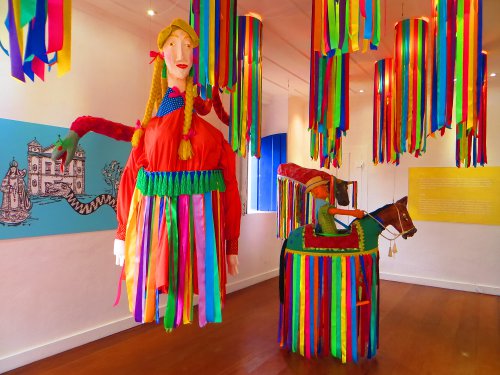
Casa da Cultura: housed in a beautiful colonial mansion, the city’s Culture House had different art exhibitions from local artists.
- Cachoeira do Toboga / Poço do Tarzan: we visited this waterfall and natural pool just outside the city. The slick rock face of the waterfall makes a perfect natural slide.
Rock Surfing on Cachoeira do Toboga
Trinidade: 25 km outside the city, this village occupies a long sweep of stunningly beautiful coastline. We hiked through dense jungle passing through the dazzling beaches of Praia Dos Ranchos, Praia do Meio, Praia do Cachadaço. The latter along with the natural pools and enormous boulders of Piscina Natural do Cachadaço are located inside Parque Nacional da Serra da Bocaina.
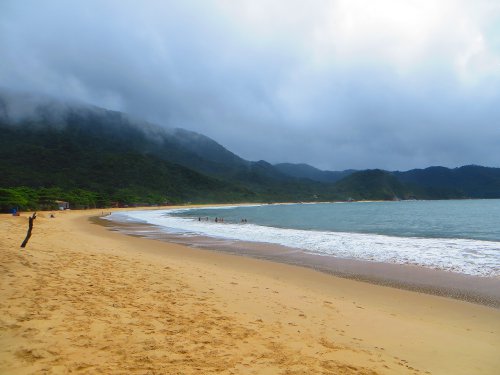
Ilha Grande
This fabulous island retreat was once a pirates’ lair, a leper colony, and a penitentiary where political prisoners were held alongside violent criminals, but now it is full of beautiful tropical beaches and virgin rainforest with only a few settlements. Vila do Abraão, the island’s biggest town, was a sleepy fishing village until the mid-1990’s when Ilha Grande’s infamous prison was destroyed and tourism on the island started. Each day we spent on the island we hiked to a different beach: the first was a total of 6km passing Praia Palmas, Praia Pouso, and swimming in Praia Lopes Mendes, which some consider to be the most beautiful in Brazil; we also hiked 1.7km along Circuito do Abraão passing the former Lazareto prison that was shut down in 1954 and now just ruins, and Poção swimming hole; and lastly, a 2-hour-hike to Dois Rios site of Colonia Penal Candido Mendes, the island’s last functinoning prison used by the military regime that took power in 1964. The prison was blown up by order of the state government in 1994 and now the reconstructed ruins houses Museu do Carcere, a museum where they display what the jail was like before. The town beach, Praia Dois Rios, is a picturesque beach where two separate rivers flow into the open Atlantic.


Rio de Janeiro
Igreja de Nossa Senhora de Candelaria: the construction of the original church, dating from the late 16th century, on the present site was credited to a ship’s captain who was nearly shipwrecked at sea. Upon his safe return he vowed to build a church. The present day church was built between 1775 and 1894 and was the largest and wealthiest church of imperial Brazil.


Mosteiro de São Bento: built between 1617 and 1641 on Morro de São Bento (Saint Bento Hill), this monastery has an excellent view over the city. The interior is completed decorated in gold.
Travessa do Comercio: this cobblestone street is lined with colonial townhouses that once was part of an old viaduct and now contains restaurants that are popular with cariocas (citizens of Rio de Janeiro).
Praça XV de Novembro: this square (November 15 Plaza) commemorates the day Brazil declared itself a republic on November 15, 1822.
Igreja de Nossa Senhora do Carmo da Antiga Se: this restored church and former cathedral dates back to the 1770’s and witnessed royal baptisms, weddings and funeral rites, and several kings were crowned here during the imperial days.
Palacio Tiradentes: we were able to tour the palace that was the seat of government between 1926 and 1960 before the capital was moved to Brasilia.
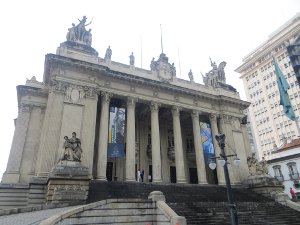

Paço Imperial: the former royal palace was originally built in 1743 and now hosts many exhibits on abstract art.
Museu Historico Nacional: this impressive National Historical Museum contains historic relics relating to the history of Brazil, exhibits included the indigenous settlers, Portuguese invasion, religious role in colonization, slaves from Africa, African life in Brazil, Portuguese monarchy in Brazil, independence, imperial state, Triple Alliance War, and the start of the republic.
Teatro Municipal: built in 1905 in the style of the Paris Opera, this Municipal Theater is the home of Rio’s opera, orchestra and ballet.
Igreja São Francisco da Penitencia: this church dates back from 1726 and has blue Portuguese tiles.
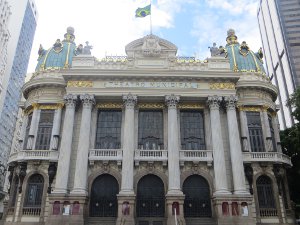
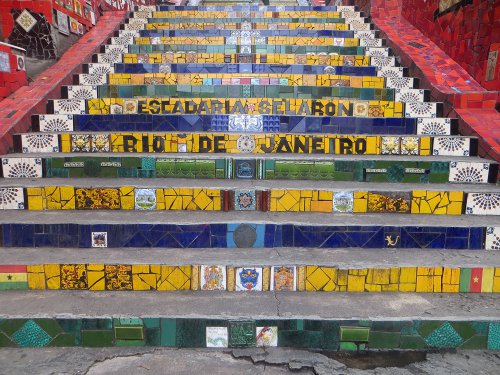
Escadaria Selaron: these steps became a work of art when Chilean-born artist Jorge Selarón, who died in 2013, decided to cover the steps with colorful mosaics. The 215-steps are a dedication to the Brazilian people with its array of vivid colors.
Catedral Metropolitana: this uniquely designed cone-shaped cathedral was inaugurated in 1976 after 12 years of construction. From the interior, the 60m (197ft) tall vivid stained-glass windows are breathtaking.
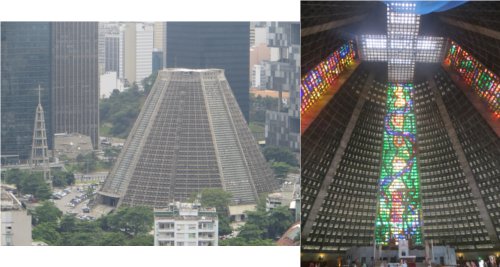

Parque das Ruinas: these ruins were of a former mansion that has been turned into a park that offers excellent views of the city from the viewing platform. This was the best view we were able to have of the carioca bay, since most of the days during our stay were cloudy.
Santa Teresa Neighborhood: set on a hill overlooking the city this bohemian neighborhood contains cobbled streets, restaurants, bars, and aging mansions that are homes to a new generation of artists.
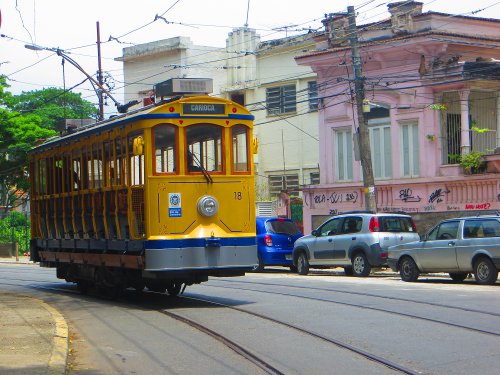
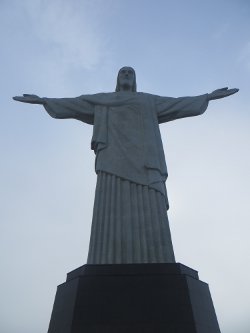
Cristo Redentor: we saw the clouds parting and made a last second decision to take the train up to Corcovado, the location where Christ the Redeemer gazes out over the city. The mountain rises straight up from the city to 710m (2330ft) and the 38m-high (125ft) statue on top. The mountain lies within the Parque Nacional da Tijuca. Unfortunately, the clouds did not act favorably, but we were able to see the statue and a few glimpses of the city.
Rio de Janeiro Beaches: we walked from one end to the other of the famous long span beaches of the city. It was difficult to determine where one beach ended and the other started, but Leme, Copacabana, Ipanema, and Leblon are the names that compose the world famous beaches. Unfortunately, due to the weather we were not able to see the beaches in full force mania, which must be a sight to see, but we were able to get a glimpse of the amazing natural surroundings of the area.
Parque Garota de Ipanema: this rocky park with great views of Ipanema Beach.


Elevador do Morro do Cantagalo: this elevator goes up to Cantagalo, a favela that is wedged between Ipanema and Copacabana, and also has a lookout point of Ipanema. We walked up a little into the favela to see everyday life.
Lagoa Rodrigo de Freitas: we walked a portion of the walkway that encircles this picturesque lake.
Mirante do Leblon: we admired Leblon Beach from this viewpoint hypocritically surrounded by a luxury hotel and a favela beyond.
Sambodromo: the epicenter of the world famous Rio Carnaval. It was designed by Oscar Niemeyer and completed in 1984.
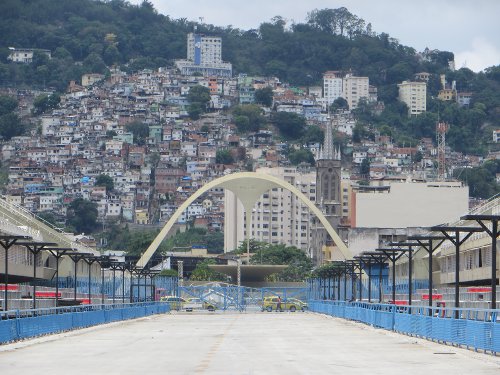
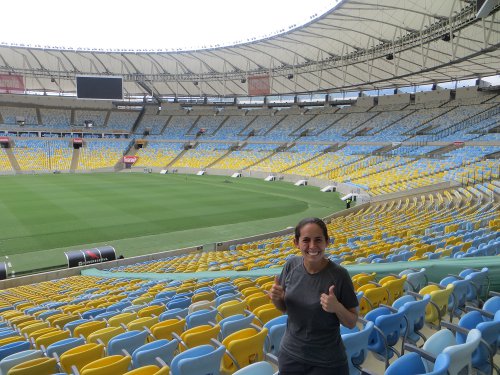
Maracana Football Stadium: we toured this Brazilian soccer temple and were able to see it from different angles. The stadium underwent a staggering 900 million reales upgrade in preparation for the 2014 World Cup.
Igreja de Nossa Senhora da Gloria do Outeiro: we were able to enter this church that dates from 1739 and became the favorite of the royal family upon their arrival in 1808.
Museu da Republica: this Museum of the Republic is located in the restored Palácio do Catete. Built between 1858 and 1866, the palace was home to the president of Brazil from 1896 until 1954, when President Getúlio Vargas committed suicide. The museum itself has a collection of classic furniture and art from the Republican period.
Parque do Flamengo: this park was the result of a landfill project that leveled the São Antônio hill in 1965. The park was designed by Brazilian landscaper Burle Marx, who also landscaped Brasília.
Samba Bar: we had a night out in Lapa, a neighborhood famous for its samba bars. We enjoyed listening to samba and trying to dance in a hole-in-the-wall bar, Beco do Rato, full of locals.
Samba Music
Ouro Preto
Praça Tiradentes: this plaza is the heart of the town, surrounded by some of the city’s finest museums and churches.
Igreja Nossa Senhora da Conceição de Antonio Dias and Museu do Aleijadinho: this church was under renovation when we visited it. But we were able to get glimpse through the scaffolding of Manuel Francisco Lisboa’s design, Aleijadinho’s father. Aleijadinho is the famous Brazilian architect/artist that designed several churches, sculptures, and paintings.


Mina do Chico-Rei: we toured the mine where the African king, Chico-Rei, worked. Chico Rei’s story is one of sadness, but at the same time courage. He, along his entire tribe, was captured in Africa, sent to Brazil, and sold to a mine owner in Ouro Preto. Working Sundays and holidays, he finally bought his freedom from the slave master and then freed his son Osmar. Together, father and son liberated the entire tribe. The communal then bought the wealthy Encardadeira gold mine, and Chico-Rei assumed his royal functions once again, holding court in Vila Rica and celebrating African holidays in traditional costume. News of this reached the Portuguese king, who immediately prohibited slaves from purchasing their freedom.
Oratorio Vira-Saia: this is one of several oratórios built on street corners around town in the early-18th-century to keep evil spirits at away.
Igreja de Santa Efigenia dos Pretos: this mid-18th-century church was financed by gold from Chico-Rei’s mine and built by the slave community.
Capela do Padre Faria: built between 1701 and 1704 and named after one of the original bandeirantes (roaming bandits who spent the 17th and 18th centuries exploring Brazil’s interior), this is the city’s oldest chapel.


Igreja de São Francisco de Assis: this church’s entire exterior was carved by Aleijadinho, from the soapstone medallion to the cannon waterspouts to the Franciscan two-bar cross. The interior was painted by Aleijadinho’s long-term partner, Manuel da Costa Ataíde.
Igreja Nossa Senhora do Carmo: built between 1766 and 1772, this church was a group effort by the area’s most important artists.
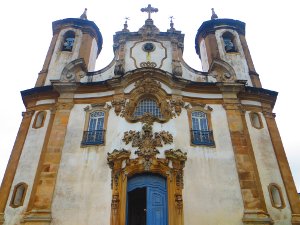

Museu da Inconfidencia: this historical museum is housed in the old municipal headquarters and jail, an beautiful building built between 1784 and 1854 on the south side of Praça Tiradentes. The museum contains exhibits on the history, life, and religious art of Ouro Preto.
Matriz Nossa Senhora do Pilar: we admired the interior of the country’s second-most wealthiest church (after Salvador’s São Francisco) with 434kg of gold and silver.
Igreja Nossa Senhora do Rosario: this baroque church is believed to be built in 1762.
Parque do Vale dos Contos: built on the site of the city’s 18th-century botanical garden, this lush public park snakes through the city with pretty views, great for a shady break.
Museu Casa dos Contos: this was a treasury building in the 18th-century and doubled as a prison for members of the Inconfidência. The museum houses displays on the history of gold, currency, and an exhibition on artifacts used on slaves.

Brasilia
TV Tower: this 75m-high observation deck offers great views of the city, but it is not tall enough to see the airplane design.
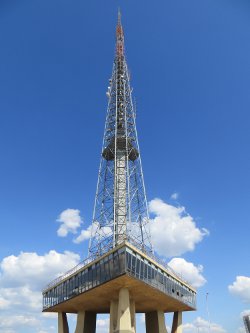

Santuario Dom Bosco: this sanctuary is made of 80 concrete columns that support 7500 pieces of illuminated Murano glass symbolizing a starry sky, which cast a beautiful underwater blue over the interior.
Biblioteca Nacional: this large building serves as the national library.
Teatro Nacional: the interesting design of the national theater looks like a water slide.
Museu Nacional: the structure where the national museum is hosted was designed by architect Oscar Niemeyer, just like most buildings in Brasilia. The spherical half-dome with a curved ramp makes it appear like Saturn. The museum itself was in the middle of a transition and we were only able to see a small temporary exhibition on World War II posters.
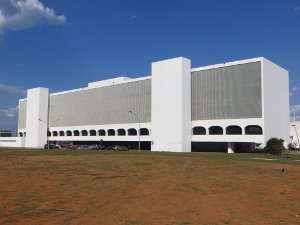

Catedral Metropolitana: the cathedral with its 16 curved columns and wavy stained-glass interior gives it a futuristic design.
- Caixa Cultural: this cultural center exhibited different financial artifacts, but the most interesting part of the center were the beautiful stained glass murals representing every state of the country.
- Praça dos Tres Poderes: the Plaza of the Three Powers is the cockpit of the airplane design. It contained a large, concrete open space with different sculptures.
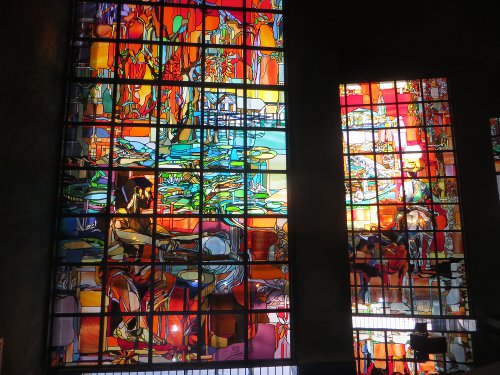
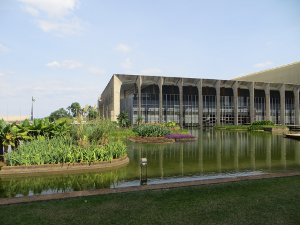
Palacio do Itamaraty: this palace is home to the Foreign Ministry and we were fortunate to not only see it the exterior, but also tour the interior. The impressive building feautres a series of arches towering over a reflecting pool and floating gardens that were landscaped by Burle Marx. The interior has large open spaces full of beautiful artwork.
Congresso Nacional: the dome, dish, and twin towers make up the national congress. The dome is where the House of Representatives meet and the dish is home to the Senate.
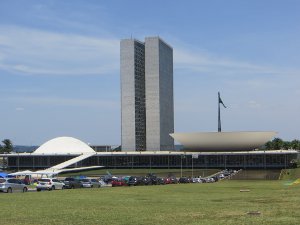

Palacio da Justicia: the beautiful Palace of Justice features several cascading waterfalls between arches that land into a koi fish pond.
Palacio do Planalto: this palace is another Niemeyer design and home the president’s office.
Pavilhao Nacional: the site of Brasília’s tallest and largest flag, the pole consists of 24 separate flagpoles welded together, each one symbolizing a Brazilian state.
Espaço Cultural Lucio Costa: this cultural space contains a scale model of the city, where we were able to view the airplane design.
Panteão da Patria e da Liberdade Tancredo Neves: this pantheon is a tribute to the principal heroes of Brazilian history, including a set of steps to an eternal flame in memory of Tancredo Neves, the elected president who died before he could assume power.
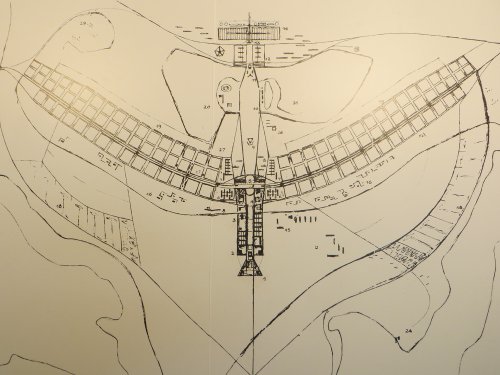
Memorial JK: a memorial and the tomb of President Juscelino Kubitschek (JK), the creator of Brasillia.

Ponte do JK: this bridge crosses the artificially built Lago do Paranoá and named after President Juscelino Kubitschek.

Templo da Boa Vontade: this temple was created by the Legion of Goodwill in 1989 as a symbol of universal solidarity. Many of these cults have sprung up around the city, because they believe Brasilia is the capital described in 1883 by an Italian priest, John Bosco, who prophesied that a new civilization would arise between parallels 15 and 20, and that its capital would be built between parallels 15 and 16, on the edge of an artificial lake.

Lençois
Igreja Senhor dos Passos: this church honors the patron saint of miners and was built by slaves.
Mercado Cultural: located on the main square, adjacent to the river, this market began construction in the 19th century.
Prefeitura Municipal: this city hall was built in 1860 and was the mansion of Colonel César Sá.
Parque Nacional Chapada Diamantina: this national park was created in 1985 and named after the diamonds that were found in riverbeds. We spent a few days doing day hikes into the park. One day we hiked about 2 hours each way to reach Cachoeira Sossego, a lovely waterfall with a deep swimming hole at its base. Another day, we took a shorter hike to Ribeirão do Meio, a series of river pools with a natural waterslide. We also toured Poço Encantado and Poço Azul, two beautiful caves filled with crystalline blue water.
Salvador
Praça Municipal: once the political seat of colonial Brazil, this plaza provides panoramic views over the bay. The impressive Palácio Rio Branco, reconstructed in 1919, is part of the plaza and the original 1549 structure housed the offices of Tomé de Souza, Brazil’s first governor general.
Praça da Se: the L-shaped, cathedral plaza has a few fountains and great for people watching.
Catedral Basilica: this cathedral dates from 1672 and is a marvelous example of Jesuit architecture.
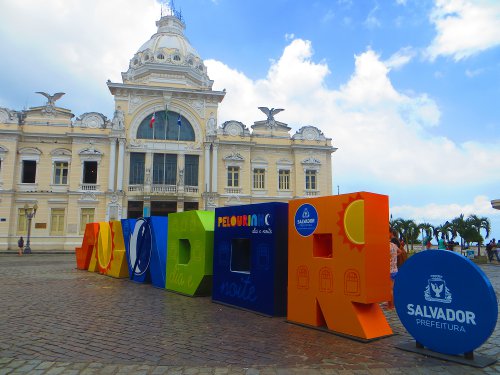

Pelourinho Neighborhood: the heart of the city and a Unesco-declared World Heritage site is full of colorful colonial buildings and magnificent churches.
Museu Afro-Brasileiro: this museum contains a large collection of wood carvings, baskets, ceramics, and metallurgy linking Brazilian and African artistic traditions. The highlight of the museum was a room lined with 27 huge carved wooden panels depicting orixas (Candomble mythical gods).
Museu de Arqueologia e Etnologia: this museum exhibits local indigenous pottery, bows and arrows, masks, and feather headpieces.
Largo do Pelourinho: this wide square was once the site of the pelourinho (whipping post) where slaves were auctioned.
Igreja Nossa Senhora do Rosario dos Pretos: the king of Portugal gave the Brotherhood of Black Men the land to build this church in 1704. Building in their free time, it took these slaves and freed slaves almost 100 years to complete it.
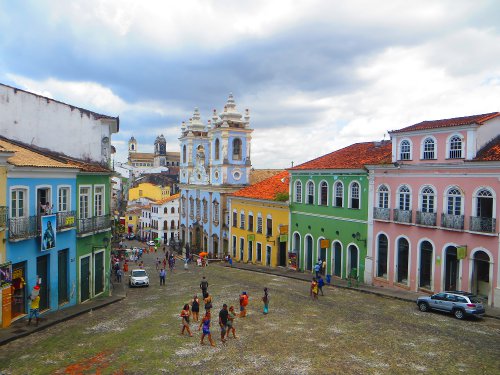
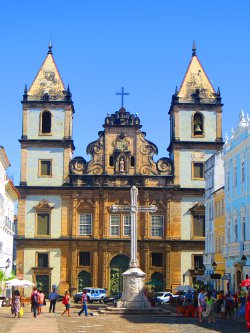
Igreja da Ordem Terceira do Carmo: the original church was founded in 1636, but burnt to the ground. The present neoclassical structure dates from 1828.
Igreja e Convento São Francisco: this baroque church is filled with displays of wealth and completed in 1723. Built by African slave artisans, they rebelled through their work by making the faces of angels distorted and some with huge sex organs, while others appear pregnant.
Elevador Lacerda: this elevator connects the Cidade Alta (High City) with Comércio. The Jesuits installed the first manual rope-and-pulley elevator around 1610 and in 1868 an iron structure was inaugurated, replaced by an electric system in 1928.
Mercado Modelo: housed in the 1861 Customs House that was burnt in 1986, the replacement resulted in this tourist market.
Fundação Casa de Jorge Amado: this foundation gave us an overview of the life and his books of one of Brazil’s best-known writers.
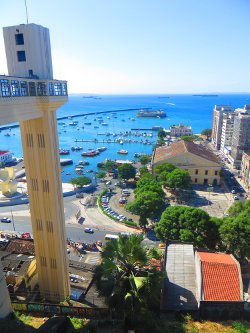
Solar do Unhão: this preserved 18th-century colonial building served as a transfer point for sugar shipments and has an interesting modern interior.
Forte São Diogo and Forte Santa Maria: Barra, a waterfront neighborhood, is occupied by three colonial forts, these two, and the most impressive of the bunch, Forte de Santo Antônio da Barra, see below.
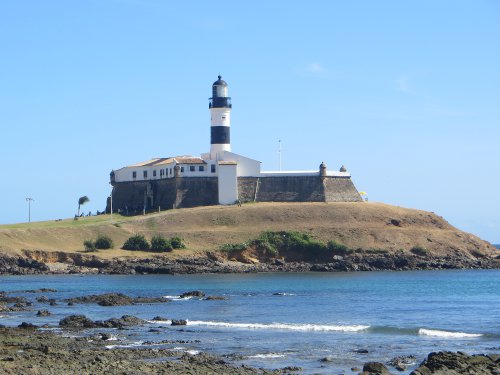
Barra Beaches: there are two beaches in this area: Praia Porto da Barra and Praia do Farol da Barra. The first is small and picturesque with vendors selling everything and the second is popular with surfers.
Forte de Santo Antonio da Barra: built in 1698, this fort is commonly called the Farol da Barra for the lighthouse. It offers superb views and houses the Museu Nautico da Bahia (Nautical Museum of Bahia) that contains relics and displays from the days of Portuguese maritime. We enjoyed the beautiful sunset from here, the peninsula is the only location in Brazil where the sun appears to set over the ocean.
Igreja Nossa Senhora do Bonfim: this 18th-century church is Candomblistas’ most important temple. It is the source of the fitas (colored ribbons) we saw throughout the city, a souvenir of the church and a symbol of Bahia itself. In the Sala dos Milagres (Room of Miracles), we witnessed wax replicas and photos of body parts representing those that were cured or need curing.

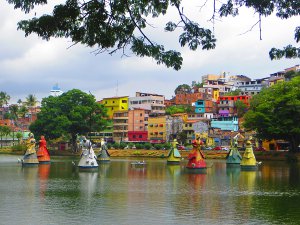
- Dique do Tororo: the only natural source of the city, we walked around this reservoir of 110 thousand cubic meters of water located in the neighborhood of Tororo.
Recife
Marco Zero: this marks the place where the Portuguese founded Recife in 1537, and has given its name to the plaza.
Parque de Esculturas de Francisco Brennand: this sculpture park was built in 2000 on an island in front of Marco Zero. We only saw it from Marco Zero, where there is a clear view of the main work of art in the complex the Crystal Column.
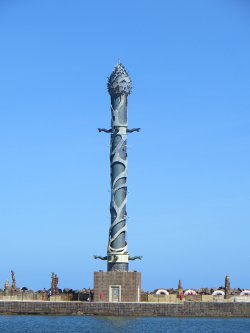

Embaixada dos Bonecos Gigantes: this place displays some of the giant puppets of different celebrities that are featured in the Olinda Carnaval.
- Sinagoga Kahal Zur Israel: this is the oldest synagogue in the Americas and now is a Jewish cultural center with interesting murals depicting the history of Jews in Recife.
- Paço do Frevo: this palace houses exhibits, performances, and classes of frevo, the dance of the Recife Carnaval. We were able to see the dance performed live and get a short class on it.
- Centro Cultural Cais do Sertão Luiz Gonzaga: this cultural center is dedicated to the Sertão region of the country and the famous forro singer Luiz Gonzaga.
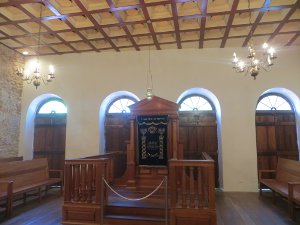
Paço Alfandega: this 19th-century customs house has been restored and kept the colonial look from the exterior and converted into a glitzy shopping mall in the interior.
Praça da Republica: this plaza is surrounded by 19th-century governmental buildings at its northern end and a commercial area in the south.

Patio de São Pedro: this plaza is lined with bars, restaurants, colorful 19th-century houses, and the 18th-century baroque Concatedral de São Pedro dos Clérigos.
Memorial Chico Science: in this memorial we were told the story of the founder of the mangue beats musical movement, who died tragically in a Recife car accident in 1997.
Praia de Boa Viagem: we walked along this sandy beach, but did not get near the water since it is famous for shark attacks. Since 1990, at least 31 shark attacks have been recorded along Recife’s shores, most of them on this beach. There were signs all over the beach warning people.
Museu da Cidade do Recife: the City Museum of Refice is housed in the Forte das Cinco Pontas (Five-Pointed Fort), built by the Dutch in 1630. It exhibits historic photos and other artwork.
Oficina Ceramica Francisco Brennand: this beautiful and peaceful space contains interesting ceramic sculptures displayed around gardens. Francisco Brennand, born in 1927 into an Irish immigrant family and now considered Brazil’s greatest ceramicist, revitalized his family’s abandoned tile factory to create this masterpiece.

Olinda
Praça do Carmo: this plaza is overlooked by the restored Igreja Nossa Senhora do Carmo built in 1580.
Mosteiro de São Bento: this huge monastery was originally built in 1582 and the church has some exceptional woodcarving.
Museu do Mamulengo: this museum exhibits several wooden puppets of the Northeastern tradition of traveling puppet shows.

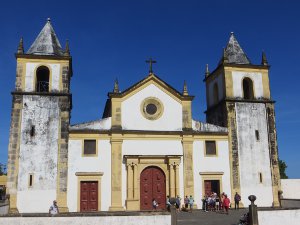
Igreja da Misericordia: this church was built in 1540 and has fine azulejos and gilded carvings.
Igreja Nossa Senhora do Amparo: we entered this 1613 church that has recently been restored.
Igreja da Se: this church was originally built in 1537, burnt in 1631 and has been reconstructed four times since, most recently from 1974 to 1984.
Convento de São Francisco: this convent contains a 16th-century church and two chapels with rich baroque detailing and lovely azulejos.
Fortaleza
Centro Dragão do Mar de Arte e Cultura: this is an extensive complex that includes cinemas, performance spaces, a cafe, a planetarium, and two good museums.
Museu de Arte Contemporanea: the Contemporary Art Museum had a temporary exhibiton on photography of nature.
Memorial da Cultura Cearense: this museum featured exhibits on Ceará’s traditional way of life and culture.
Praia do Meireles: this beach has numerous beach bars and skyscrapers.
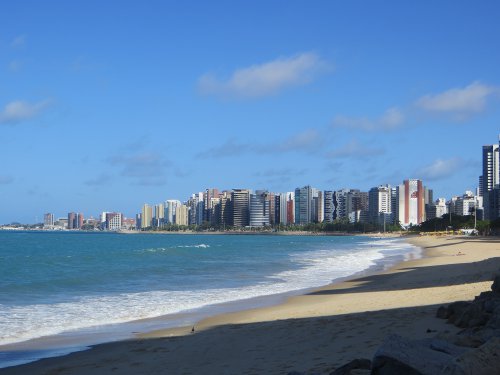
Jericoacoara
Praia Principal: we were able to swim for and enjoy this beach in front of the town while we waited for the sunset.
Duna do Por-do Sol: a little before dusk we hiked up this Sunset Dune to try to see the so called ‘Emerald Sunset.’ From this location the tip of the sun is supposed to turn bright green before it slides into the horizon, but did not see green anywhere on the sun. We still enjoyed the sunset.
Capoeira: right before sunset a group forms on the beach practicing capoeira, the famous Brazilian martial art/dance.
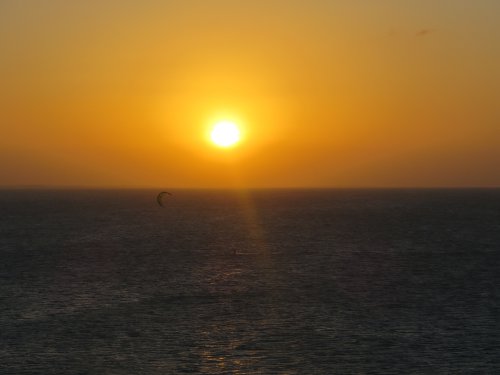
Capoeira on the Beach
Tour of the Surroundings: we took a day tour of several surrounding sights, including Lagoa Paraiso, a paradise lagoon with hammocks in crystalline waters; Lagoa Azul, another lagoon where we made a stop to take pictures; Praia Prea, a beach where we had lunch; Arvore de Preguiça, the lazy tree, a tree leaning over on its side; and Pedra Furada: a perforated rock right where the ocean breaks.
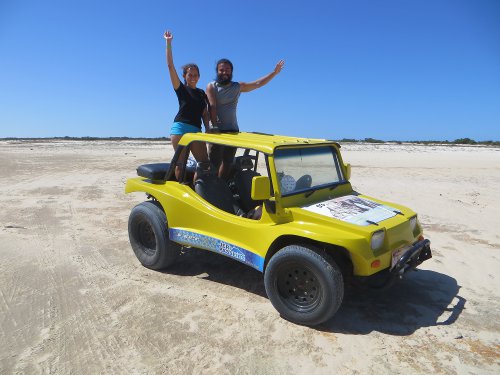

Atins
Parque Nacional Lençois Marenheses: one of our favorite, this national park is named after its immense expanses of dunes, which look like lençóis (bed sheets). The park is at its peak beauty during and right after the rainy season when the spaces between the dunes fill with water. Unfortunately, we arrived during the dry season. The first full day we were there, we spent it walking through the dunes in search of any lagoons that had not dried, but we did not have any luck. The next day, our friend Annick, who we met a couple days prior, had rented a 4×4 car with a guide to find the lagoons and she kindly invited us along. We were in for a surprise, we arrived to Queimada dos Britos, a large lagoon in the middle of large dunes, a spectacular sight. The landscape was amazing, we were left speechless, one of the most fascinating scenery our eyes have seen. We spent a few hours swimming and rolling in the dunes. Our words cannot express the appreciation we felt for our friend, Annick. Thank you so much!
Rolling in the Dunes
São Luis
Cafua das Merces: a former ‘holding facility’ or residence of slaves that newly arrived from Africa, this small museum had interesting exhibits on slavery, the slave trade, and Afro-Brazilian culture.
Centro de Cultura Popular: this cultural center exhibited the city’s different festivals, such as Carnaval, Bumba Meu Boi, and Divino Espírito Santo.
Casa de Tulhas: we had lunch and tried a few local specialties in this 19th-century market building. There were also a variety of typical local crafts.
Centro de Historia Natural e Arqueologia do Maranhao: this Natural History and Archealogical Center of Maranhao exhibited different artifacts from the region history, from dinosaurs to indigenous culture.

Casa de Nhozinho: this museum had a collection of fish traps, indigenous artisanry, a hosts of colorful traditional festival costumes, and puppets.
Palacio dos Leões: the state governor’s palace was built in the 18th century on the site of an original French fort and protected by two leões (lion statues).
Belem
Estacão das Docas: a renovation project converted three riverfront warehouses into this popular gathering spot with restaurants, bars, and shops. It was our hangout spot for a couple of days as well, where we had some beers and listened to live music.
Mercado Ver-o-Peso: the name of this waterfront market comes from colonial times, when the Portuguese would ver o peso (check the weight) of merchandise in order to impose taxes. The market displays an impressive array of tropical fruit, plants, different type of fish, and much more.
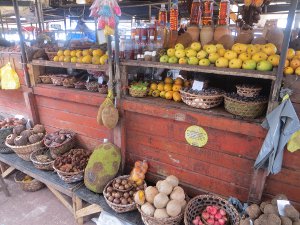
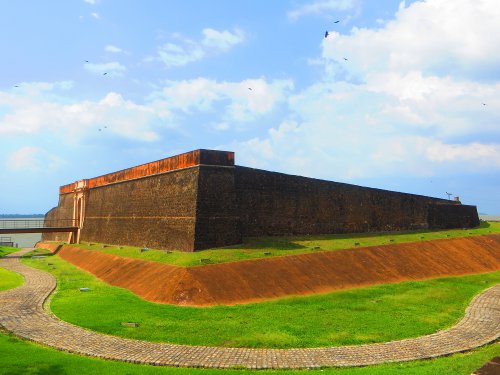
Forte do Presepio: in 1616, the city was founded with the construction of this imposing fort. Today, it houses a small museum of local indigenous communities and has great river and city views the top of its thick stone walls.
Catedral da Se: the city’s historic cathedral recently underwent a major renovation.
Museu do Estado do Para: hosted in Palácio Lauro Sodré, the former residence of Portugal’s royal representatives and later of various governors of the state, this museum contains a boring collection of antique furniture and very little on the history of the city and state.


Teatro da Paz: one of the city’s finest buildings, this theater was completed in 1874 and built in neoclassical style.
Museu Emilio Goeldi: this museum had an excellent collection of artifacts of Amazon indigenous people and a zoo full of Amazonian animals, such as macaws, sloths, monkeys, and coatis.

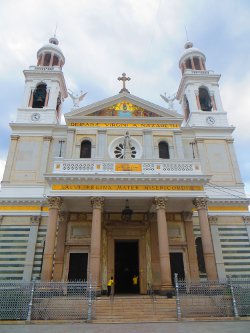
Basilica Santuario de Nazare: this basilica is the focal point of Brazil’s largest religious festival, Círio de Nazare.
Amazon Ferry
We spent three nights on board a ferry sleeping on hammocks through the Amazon from Belem to Santarem. We relaxed most of the time, while admiring the Amazon River and jungle, although we were sad to see some patches of the jungle cleared for cow grazing. There were also a few villages we passed where the locals would come out on canoes to wait to see if people on board would throw them bags of clothes or other items.

Alter do Chão
Ilha do Amor: this Island of Love is a picturesque white-sand island directly in front of town. The water was low enough to walk across, enjoy the beach restaurants, and swim in the cool calm water of Lago Verde.
FLONA, Floresta Nacional do Tapajos: we left on a speed boat for the day to visit this 5440-sq-km reserve. We arrived to Jamaraqua, one of many river villages in the reserve, where we met with a guide and hiked for about 5 hours learning about different plants and animals in the Amazon. The most impressive sight was the behemoth samauma trees with trunks that need more than 20 people to stretch their arms around. The communities primarily live off of tourism and rubber tapping. We were able to see some of the rubber craft they made. We ended our visit with a swim and short canoe ride through an inlet full of birds. On our way back to Alter do Chão, we stopped to see the sunset and were luckily to see some dolphins at a distance.

Manaus
Mercado Municipal Adolfo Lisboa: we were able to have lunch in this market that was constructed between 1880 and 1883.
Museu Amazonico: this small museum contained several artifacts of Amazon tribes, such as hunting tools and masks and costumes used in rituals.
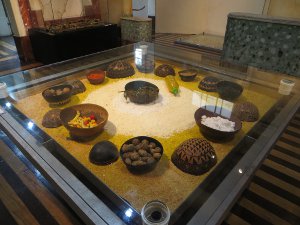

Teatro Amazonas: we were able to tour this gorgeous theater inside and out that was built at the height of the rubber boom using European designers and decorators.
Amazon Jungle Tour: we took a three-night, three-day tour in the Amazon along the Urubu River, northwest of Manaus. Two of the three nights we slept in hammocks in a peaceful lodge and the other night we spent in a campsite in the middle of the jungle. We performed various activities such as piranha fishing, spotting caiman at night while enjoying the beautiful Amazon stars, hiking in the jungle finding tarantulas and sloths, watching pink and gray dolphins coming up for air, seeing the beautiful river sunrise, and visiting a local Amazon family. Overall, the experience was nice, but we were not in the wild as much as we had hoped for.

Catedral Metropolitana de Manaus: the original church dates back to 1695, but this cathedral was built in 1878 with a Greek style. The majority of the materials were imported from Europe, especially Portugal.
Porto Flutuante: inaugurated in 1902, this ‘floating port’ was a technical marvel of its day, able to adjust 15m or more to seasonal water levels. We were able to view a wall that measures the varying water levels reached each year.

Centro Cultural dos Povos da Amazônia: this massive cultural complex houses the excellent Museu do Homem do Norte (Museum of Northern Man), which contains an incredible array of artifacts and exhibits on Amazonian indigenous groups. The complex also contains a replica of a maloca (large traditional indigenous structure) and an outstanding collection of life-like statues of indigenous people by Peruvian sculptor Felipe Lettersten.
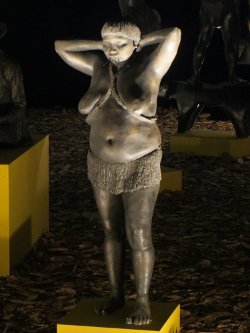
Palacete Provincial: this palace hosts a museum with various exhibits that vary from cinematography, an art gallery, archaeology display, a police museum, and a coin museum.
Centro Cultural Usina Chamine: also known as the Museu dos Cinco Sentidos (Museum of the Five Senses), this museum uses the five senses to evoke and illustrate indigenous and coboclo (mixed race) life and culture. We were able to hear recordings of native languages; smell, touch, and see Amazonian food and spices; admire indigenous folk art and instruments; and watch a few videos about the Amazon.

